Health & Wellness
Discharge Before Period: Causes, Symptoms, and Management
Published
1 year agoon
By
Charlotte

Discharge before a period can be a common occurrence for many individuals, often indicating changes in hormone levels and reproductive health. Understanding the causes, symptoms, and potential implications of discharge before your period is essential for maintaining overall well-being. In this comprehensive guide, we’ll explore everything you need to know about discharge before your period, including its causes, symptoms, and when to seek medical assistance.
Table of Contents
- 1 Introduction
- 2 1. Understanding the Menstrual Cycle
- 3 2: Discharge as a Normal Occurrence
- 4 3: Types of Vaginal Discharge
- 5 4: Discharge Before Period: What’s Normal?
- 6 5: Causes of Discharge Before Period
- 7 6: Hormonal Influences on Discharge
- 8 7: Infections and Discharge
- 9 8: Other Health Conditions and Discharge
- 10 9: Symptoms Accompanying Discharge
- 11 10: Diagnostic Approaches
- 12 11: Treatment Options
- 13 12: Preventive Measures
- 14 13: When to Seek Medical Help
- 15 14: Addressing Psychological Impact
- 16 15: Empowering Women’s Health
Introduction
Discharge before a period, also known as premenstrual discharge, is a natural phenomenon experienced by many individuals with menstrual cycles. This discharge typically occurs in the days leading up to menstruation and is influenced by hormonal changes in the body. While discharge before a period is often normal, certain factors may indicate an underlying issue that requires medical attention. In this guide, we’ll delve into the various causes of discharge before your period, common symptoms to watch out for, and when it may be necessary to consult a healthcare professional.
1. Understanding the Menstrual Cycle
The menstrual cycle is a vital aspect of reproductive health for many women and people assigned female at birth. Understanding its intricacies is essential for recognizing normal and abnormal patterns in the body. The menstrual cycle is typically around 28 days long, though it can vary from person to person. It is divided into several phases:
- Menstrual Phase: This is when menstruation occurs, typically lasting from 3 to 7 days. The uterine lining sheds, resulting in menstrual bleeding.
- Follicular Phase: After menstruation, the body prepares for ovulation. The pituitary gland releases follicle-stimulating hormone (FSH), which stimulates the growth of follicles in the ovaries. One follicle will mature into an egg.
- Ovulation Phase: Mid-cycle, usually around day 14, the mature egg is released from the ovary. This is triggered by a surge in luteinizing hormone (LH). The egg travels down the fallopian tube, where it can be fertilized by sperm.
- Luteal Phase: After ovulation, the body produces more progesterone to prepare the uterine lining for a potential pregnancy. If fertilization does not occur, progesterone levels drop, leading to the start of the menstrual phase.
Throughout these phases, hormonal fluctuations significantly impact various bodily functions, including the production and characteristics of vaginal discharge.
2: Discharge as a Normal Occurrence
Vaginal discharge is a normal and healthy part of a functioning reproductive system. It serves several essential purposes, as detailed in this comprehensive guide on vaginal discharge.
- Cleaning: Discharge helps cleanse the vagina by flushing out dead cells and bacteria.
- Lubrication: It maintains vaginal moisture, which is crucial for comfort and sexual activity.
- Protection: Discharge contains antibodies and natural substances that help prevent infections.
The characteristics of vaginal discharge can vary throughout the menstrual cycle due to hormonal changes. Understanding these variations is key to recognizing what is normal for your body.
3: Types of Vaginal Discharge
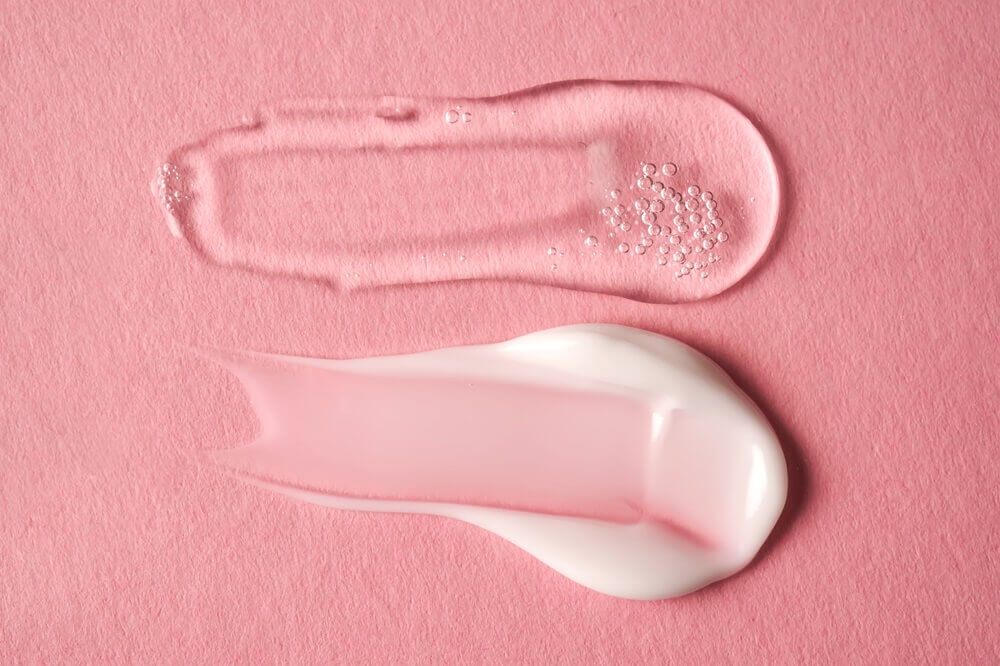

Vaginal discharge can appear in different forms, each indicating various stages of the menstrual cycle or potential health issues. Here are the common types:
- Clear and Watery: This type of discharge is often seen during ovulation, sexual arousal, or physical exercise. It is typically normal and indicates healthy lubrication.
- White and Creamy: Commonly observed at the beginning and end of the menstrual cycle. It is generally normal, although if accompanied by itching or odor, it could signal an infection like a yeast infection.
- Yellow or Green: This type of discharge might be normal if it is pale yellow and odorless. However, bright yellow or green discharge, especially if thick or accompanied by a foul smell, could indicate a bacterial or sexually transmitted infection (STI).
- Brown or Bloody: This can occur after menstruation, representing old blood being expelled. Spotting between periods or brown discharge could also be an early sign of pregnancy or perimenopause. Persistent brown or bloody discharge should be evaluated by a healthcare provider.
Understanding these variations helps in identifying normal versus abnormal discharge.
4: Discharge Before Period: What’s Normal?
Before menstruation, many individuals notice changes in their vaginal discharge. Common patterns include:
- Increased Discharge: Many experience an increase in discharge volume before their period due to the hormonal changes that prepare the uterus for menstruation.
- Thicker Consistency: The discharge may become thicker or creamier, resembling the texture of the lotion. This is influenced by the rise in progesterone during the luteal phase.
- White or Cloudy Appearance: Normal pre-menstrual discharge can appear white or cloudy without any strong odor. This is part of the body’s natural cycle and helps maintain vaginal health.
Understanding these typical patterns can alleviate concerns and help individuals identify what is normal for their bodies.
5: Causes of Discharge Before Period
Several factors can lead to changes in discharge before menstruation:
- Hormonal Changes: Fluctuations in estrogen and progesterone levels throughout the menstrual cycle are the primary drivers of changes in discharge consistency and volume.
- Infections: Bacterial vaginosis, yeast infections, and STIs can cause abnormal discharge. Infections often lead to additional symptoms such as itching, burning, or unpleasant odor.
- Health Conditions: Conditions such as polycystic ovary syndrome (PCOS), cervical polyps, or endometriosis can influence discharge patterns. These conditions may require medical evaluation and management.
Recognizing the underlying causes can help in seeking appropriate treatment if necessary.
6: Hormonal Influences on Discharge


Hormonal fluctuations during the menstrual cycle significantly impact vaginal discharge:
- Estrogen: During the follicular phase of the menstrual cycle, rising estrogen levels lead to an increase in clear, stretchy discharge. This type of cervical mucus is highly conducive to sperm movement, facilitating easier travel through the cervix to potentially result in fertilization. Understanding these bodily changes can be crucial for fertility awareness and reproductive health. For more in-depth information on exploring our comprehensive guide on high estrogen symptoms and effective treatments.
- Progesterone: After ovulation, progesterone levels rise, causing the discharge to become thicker and less copious. This change helps create a barrier to protect the uterus if pregnancy occurs.
- Hormonal Imbalances: Imbalances caused by stress, illness, or hormonal disorders can result in abnormal discharge. It is essential to monitor any changes and consult with a healthcare provider if there are concerns.
Understanding these hormonal influences can provide insight into what is normal and when to seek medical advice.
7: Infections and Discharge
Infections can lead to abnormal vaginal discharge. Common infections include:
- Yeast Infections: Characterized by thick, white, cottage cheese-like discharge, yeast infections often cause itching and irritation. Over-the-counter antifungal treatments can be effective.
- Bacterial Vaginosis (BV): BV results in a thin, grayish discharge with a fishy odor. It is caused by an imbalance in vaginal bacteria and often requires prescription antibiotics.
- Sexually Transmitted Infections (STIs): STIs such as chlamydia, gonorrhea, and trichomoniasis can cause abnormal discharge. These infections typically need medical treatment and can have serious health implications if left untreated.
Identifying and treating infections promptly is crucial for maintaining reproductive health.
8: Other Health Conditions and Discharge
Certain health conditions can influence vaginal discharge:
- Cervical Polyps: Benign growths on the cervix can cause increased or unusual discharge, sometimes mixed with blood. Polyps often require removal by a healthcare provider.
- Fibroids: Non-cancerous tumors in the uterus can lead to heavy or prolonged discharge, especially around menstruation. Management may include medication or surgical options.
- Endometriosis: This condition, where uterine tissue grows outside the uterus, can cause abnormal discharge, pain, and heavy periods. Treatment may involve hormonal therapy or surgery.
Understanding these conditions and their impact on discharge can help individuals seek appropriate care and management.
9: Symptoms Accompanying Discharge
Abnormal vaginal discharge can be accompanied by various symptoms, indicating underlying issues:
- Itching and Burning: Often associated with infections like yeast infections or BV. These symptoms should be evaluated by a healthcare provider.
- Odor: A strong or unpleasant odor can signal an infection, such as BV or an STI. It is important to seek medical advice for proper diagnosis and treatment.
- Pelvic Discomfort: Pain or discomfort in the pelvic region, along with abnormal discharge, can indicate conditions such as endometriosis or fibroids. Medical evaluation is necessary for appropriate management.
Recognizing these accompanying symptoms can aid in early diagnosis and treatment of potential health issues.
10: Diagnostic Approaches
Healthcare providers use various diagnostic methods to identify the cause of abnormal vaginal discharge:
- Physical Exam: A thorough pelvic exam allows the provider to inspect the vaginal and cervical area for signs of infection or other abnormalities.
- Laboratory Tests: Swabs of vaginal discharge can be analyzed to identify bacterial or fungal infections, STIs, or other pathogens.
- Imaging Studies: Ultrasound or MRI may be used to detect structural issues such as fibroids, polyps, or ovarian cysts.
Accurate diagnosis is essential for effective treatment and management.
11: Treatment Options
Various treatment options are available for managing abnormal discharge:
- Medications: Antibiotics for bacterial infections, antifungal treatments for yeast infections, and antiviral medications for certain STIs are common treatments.
- Lifestyle Modifications: Maintaining good hygiene, wearing breathable cotton underwear, and avoiding douches or scented products can help prevent infections and irritation.
- Home Remedies: Some individuals find relief with natural remedies like probiotics, apple cider vinegar baths, or tea tree oil suppositories. It is important to consult a healthcare provider before trying home remedies.
Effective treatment requires a combination of medical intervention and healthy lifestyle choices.
12: Preventive Measures
Maintaining vaginal health and preventing abnormal discharge involves several strategies:
- Safe Sex Practices: Using condoms and having regular STI screenings can reduce the risk of infections.
- Good Hygiene: Regular washing with mild, unscented soap and water, and avoiding harsh products can help maintain the natural balance of vaginal flora.
- Diet and Hydration: A balanced diet rich in probiotics, staying hydrated, and avoiding excessive sugar can support vaginal health.
Preventive measures are key to reducing the risk of infections and maintaining overall reproductive health.
13: When to Seek Medical Help
It is important to seek medical attention for abnormal vaginal discharge if:
- Persistent Symptoms: If abnormal discharge lasts more than a few days or is recurrent, it should be evaluated by a healthcare provider.
- Severe Discomfort: Intense itching, burning, or pelvic pain requires medical assessment.
- Concerns About Reproductive Health: Any worries about fertility, pregnancy, or overall reproductive health should be discussed with a healthcare professional.
Timely medical intervention can address underlying issues and prevent complications.
14: Addressing Psychological Impact
Abnormal discharge can have a psychological impact, causing stress and anxiety:
- Understanding: Recognizing that discharge variations are often normal and that medical help is available for abnormalities can alleviate anxiety.
- Support: Talking to a trusted friend, partner, or healthcare provider about concerns can provide emotional support and reassurance.
- Education: Educating oneself about vaginal health and normal discharge patterns can empower individuals to make informed decisions about their health.
Addressing the psychological impact is an important aspect of overall well-being.
15: Empowering Women’s Health
Understanding vaginal discharge and its variations is essential for reproductive health:
- Knowledge: Educating oneself about the menstrual cycle and normal discharge patterns is empowering and helps in identifying potential issues early.
- Advocacy: Advocating for one’s health by seeking medical help when needed and discussing concerns openly with healthcare providers is crucial.
- Destigmatization: Breaking the stigma around discussions of vaginal health encourages open dialogue and promotes better health outcomes.
Empowering women with knowledge and support fosters a healthier, more informed approach to reproductive health.
In conclusion, understanding the menstrual cycle, recognizing normal and abnormal discharge patterns, and seeking appropriate medical care are essential components of maintaining reproductive health. By educating oneself and advocating for their health, individuals can navigate their reproductive journey with confidence and support.
About the author


Charlotte
Charlotte is a health, beauty and wellness blogger and a mother of two, who lives between India and London
- July 22, 2020
- August 3, 2020
- August 10, 2020
Charlotte is a health, beauty and wellness blogger and a mother of two, who lives between India and London


You may like
Health & Wellness
Remarkable Benefits of Clove Water: A Deep Dive into Nature’s Elixir
In the vast tapestry of natural remedies and culinary delights, few ingredients possess the unassuming power and profound history of the humble clove.
Published
9 hours agoon
July 30, 2025By
Admin

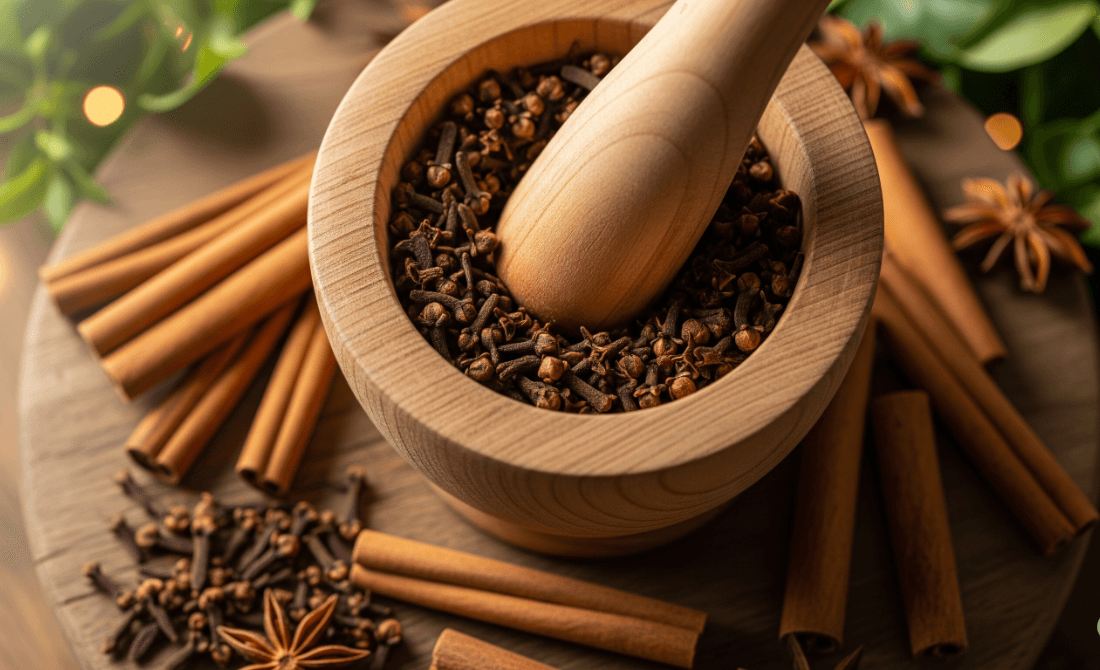

Table of Contents
- 1 The Powerhouse Within: Understanding Cloves
- 2 Comprehensive Health Benefits of Clove Water
- 3 How to Prepare and Use Clove Water
- 4 Recommended Dosages and Frequency:
- 5 Important Considerations and Precautions
- 6 Clove Oil vs. Clove Water: A Critical Distinction
- 7 Potential Side Effects and Interactions
- 8 Pregnancy and Breastfeeding Considerations
- 9 Importance of Consulting a Healthcare Professional
- 10 Conclusion
The Powerhouse Within: Understanding Cloves
Comprehensive Health Benefits of Clove Water
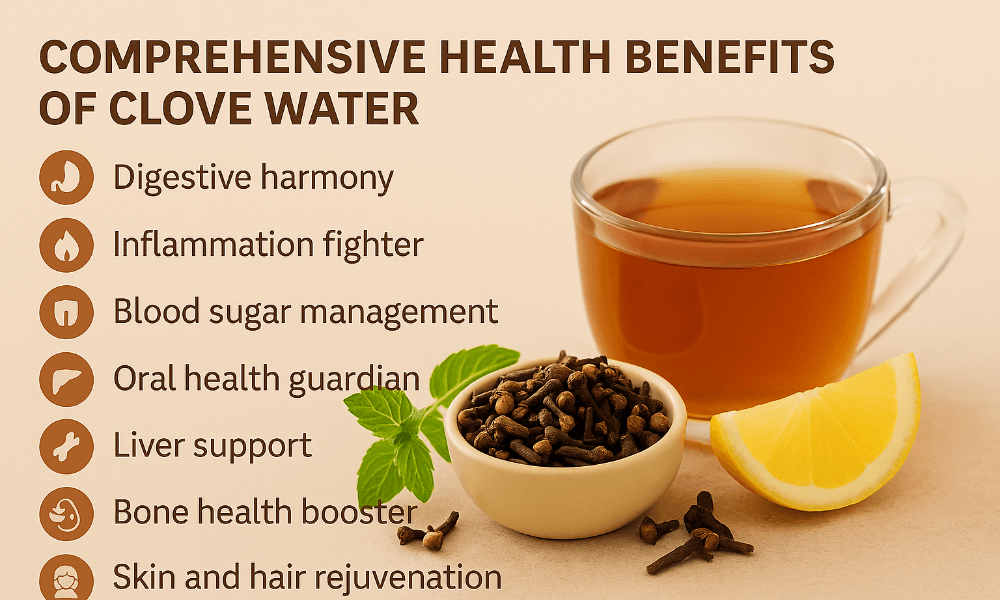

Oral Health Guardian
Digestive Harmony
Inflammation Fighter
Blood Sugar Management
Liver Support
Bone Health Booster
Respiratory Relief
Skin and Hair Rejuvenation
How to Prepare and Use Clove Water


Simple Preparation Methods:
- Ingredients: 10-15 whole cloves,
- 1 liter of filtered water.
- Ingredients: 5-7 whole cloves,
- 1-2 cups of water.
Instructions: Bring the water to a boil in a saucepan. Add the whole cloves to the boiling water. Reduce the heat and let it simmer for 5-10 minutes. This allows the beneficial compounds to be extracted more quickly. Strain the cloves out before drinking, or consume warm with the cloves still in.
Recommended Dosages and Frequency:
Tips for Incorporation:
- Start Small: If you are new to clove water, begin with a smaller number of cloves (e.g., 5-7 per liter) and gradually increase the concentration as your palate adjusts.
- Flavor Enhancements: While clove water has a distinct, warm, and slightly spicy flavor, you can enhance it by adding a slice of lemon, a few mint leaves, or a dash of honey (after cooling if using the boiling method) for added taste and benefits.
- Storage: Prepared clove water can be stored in the refrigerator for up to 2-3 days. Beyond that, it’s best to prepare a fresh batch to ensure potency and freshness.
- Consistency is Key: Like many natural remedies, the benefits of clove water are often cumulative. Regular and consistent consumption is more likely to yield noticeable results than sporadic use.
Important Considerations and Precautions


Clove Oil vs. Clove Water: A Critical Distinction
Potential Side Effects and Interactions
1. Blood Thinners (Anticoagulants):
2. Diabetes Medications:
3. Surgery:
Pregnancy and Breastfeeding Considerations
Importance of Consulting a Healthcare Professional
Conclusion
About the author
- July 2, 2020
- July 20, 2020
- June 29, 2021
Health & Wellness
Does Protein Powder Expire? A Guide to Shelf Life, Storage & Safety
Ever wondered if that dusty tub of protein powder in your pantry is still good? If you’ve ever paused before mixing your shake, you’re not alone.
Published
3 days agoon
July 28, 2025By
Admin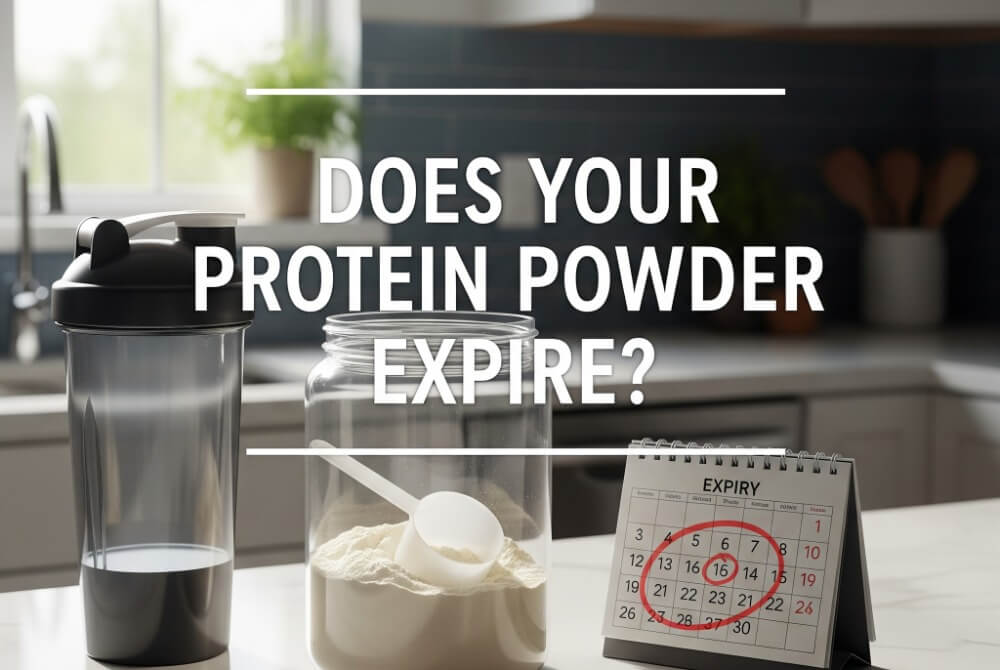

Ever wondered if that dusty tub of protein powder in your pantry is still good? If you’ve ever paused before mixing your shake, you’re not alone. Whether you’re a gym-goer, athlete, or someone trying to meet daily protein goals, protein powder is a household staple for millions.
With the global protein supplement market crossing $6 billion annually, understanding does protein powder expire is not just a curiosity—it’s essential. Knowing the real story behind expiration labels can save you money and protect your health.
In this guide, we’ll answer all your questions: what does the protein powder expiration date really mean, how long does protein powder last, how to store it properly, whether it’s safe to use expired powder, and what the latest 2025 trends are in supplement preservation.
Table of Contents
- 1 Does Protein Powder Really Expire?
- 2 Types of Protein Powder and Their Shelf Life
- 3 How to Store Protein Powder for Maximum Freshness
- 4 Is Expired Protein Powder Safe to Use?
- 5 Signs Your Protein Powder Has Expired
- 6 Latest Trends and Updates for 2025
- 7 Practical Tips for Using and Disposing Protein Powder
- 8 Conclusion
Does Protein Powder Really Expire?
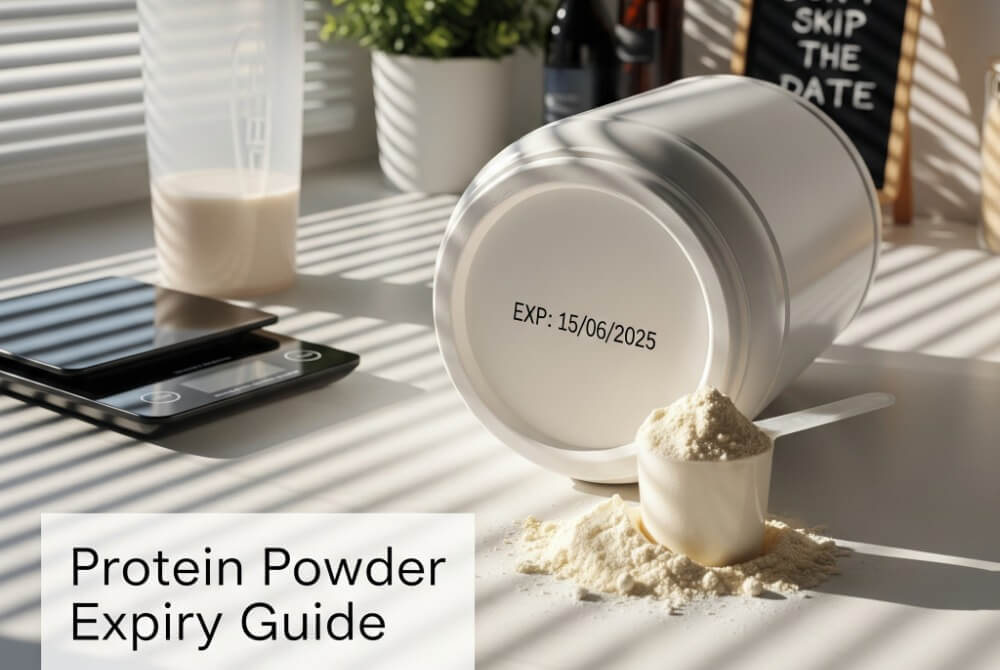

The short answer? Yes, but it’s not always as serious as you might think.
Most protein powders come with a “best by” or “expiration date” on the packaging. This is provided by the manufacturer and usually refers to when the product is at peak quality—not necessarily when it becomes dangerous to consume.
So, does protein powder expire in a way that makes it unsafe? Not always. In fact, unopened powder can last 1 to 2 years past its manufacture date. Once opened, most types last 6 to 9 months, depending on storage conditions.
That said, flavor, texture, and nutritional quality can degrade over time. So while using it after the protein powder expiration date won’t always hurt you, the experience might be less enjoyable—and the benefits slightly reduced.
Types of Protein Powder and Their Shelf Life
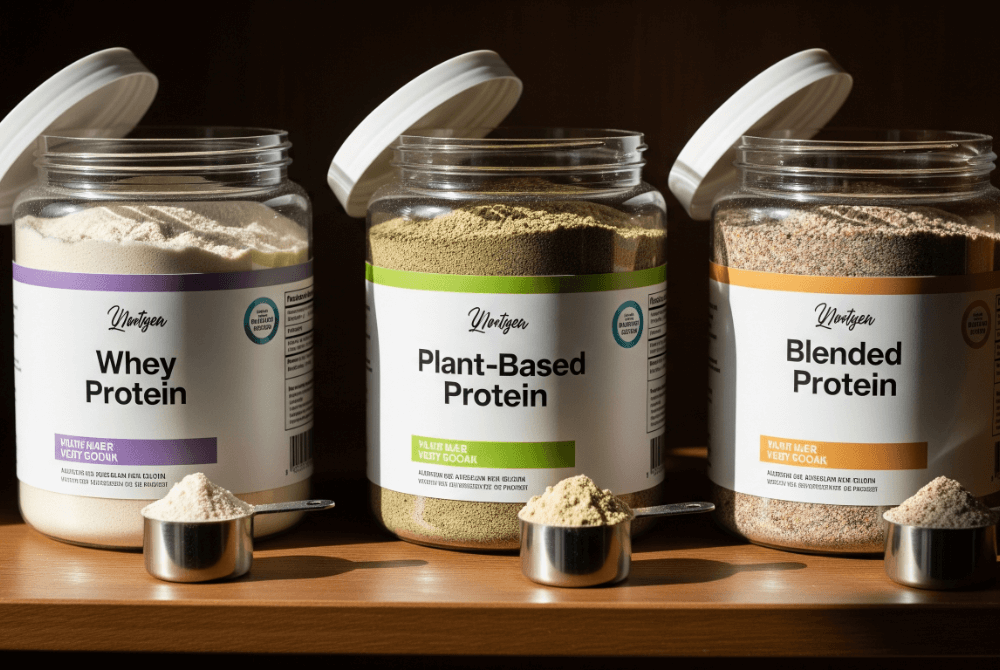

Different protein types have different longevity. Here’s a closer look:
1. Whey Protein
Does whey protein expire more quickly than others? In many cases, yes. Since whey is derived from dairy, it’s more sensitive to moisture and heat.
-
Unopened: 12–24 months
-
Opened: 6–9 months
Signs of spoilage include strong off odors, yellowing, and clumping. If you detect any of these, it’s time to toss it.
2. Plant-Based Protein
Made from peas, soy, rice, or hemp, plant-based proteins tend to have a similar protein powder shelf life—about 1–2 years unopened.
However, powders with natural flavors, oils, or sweeteners may degrade faster. Airtight storage is key to prevent rancidity and nutrient loss.
3. Blended Proteins
Many popular powders now contain blends of multiple protein sources along with vitamins, probiotics, or herbal extracts. These combinations can lead to shorter shelf lives, as ingredients may interact or degrade faster.
Always check the label, as some blends recommend use within 6–12 months, even when unopened.
How to Store Protein Powder for Maximum Freshness
Your storage method plays a major role in how long protein powder lasts. Here’s how to maximize freshness:
-
Cool & Dry Location: Store your tub in a pantry or cupboard away from heat and sunlight. Keep temperatures below 25°C (77°F).
-
Airtight Containers: Once opened, use a resealable container with minimal air exposure. Avoid letting moisture in through wet scoops or condensation.
-
Avoid the Fridge: While it seems like a good idea, refrigerators can introduce moisture and cause clumping.
-
Label the Opening Date: Write the date you first opened the product on the container. This helps you track the protein powder expiration date more accurately.
By following these steps, you can extend your protein powder shelf life by 3–6 months beyond the listed date without significant quality loss.
Is Expired Protein Powder Safe to Use?
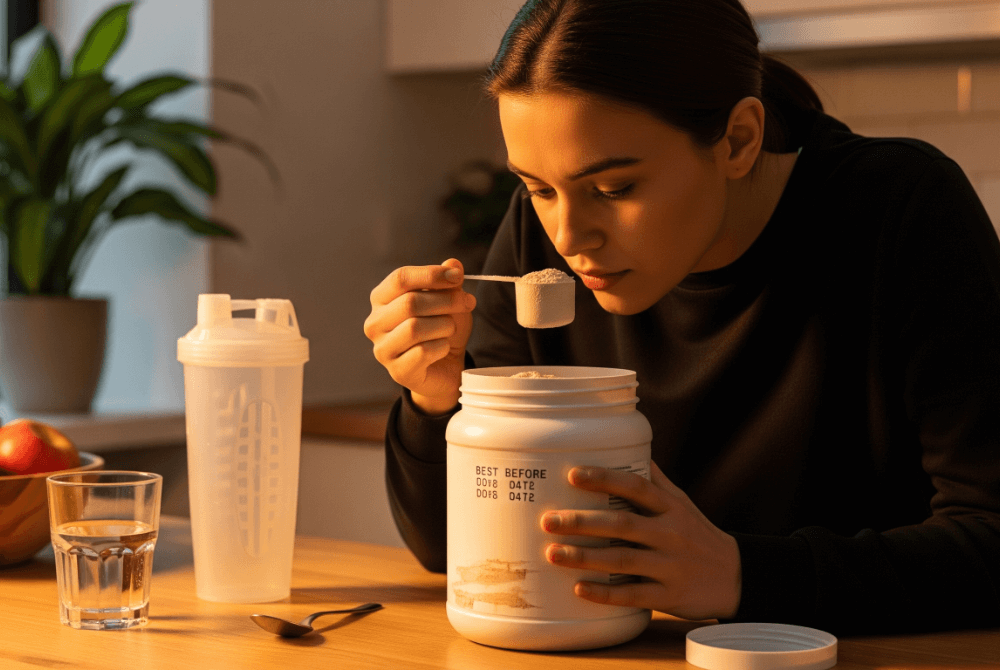

One of the most common concerns is: Is expired protein powder safe?
In many cases, yes—but with conditions.
If the powder has been stored properly—airtight, cool, and dry—it’s generally safe to consume for several months past the expiration. The key is inspecting for signs protein powder has expired:
-
No foul odor
-
No mold or visible discoloration
-
No clumping or wetness
Mix a small amount in water and taste it. If it’s bland or slightly off, it might still be safe but less effective. If it tastes bitter, chalky, or smells rancid—toss it.
Can you use expired protein powder from a mixed formula with herbs or vitamins? That’s riskier. These ingredients break down faster and could become harmful. Avoid using expired blends with such additives.
Signs Your Protein Powder Has Expired
Knowing when to part ways with your powder is essential for safety.
Look out for these signs protein powder has expired:
-
Rancid Smell: A strong, sour, or metallic odor is a red flag.
-
Clumping: Moisture can cause clumps, which may harbor mold or bacteria.
-
Discoloration: Yellowing or dark spots suggest oxidation or contamination.
-
Odd Taste: Bitter or stale flavor means the protein or flavoring agents have likely degraded.
Always trust your senses. If the powder looks, smells, or tastes off—even if it’s before the protein powder expiration date—don’t take the risk.
Latest Trends and Updates for 2025
The protein powder industry in 2025 is focusing heavily on shelf life improvements and clearer labeling.
-
Natural Preservatives: Brands are moving away from synthetic additives, instead using fermented ingredients or botanical preservatives to extend freshness.
-
Vacuum-Sealed Packaging: New airtight pouches with oxygen-absorbing liners help prolong the protein powder shelf life.
-
Improved Expiry Labels: There’s increasing pressure on brands to specify “Opened By” vs. “Best Before” dates to clarify confusion.
Even discussions around is expired protein powder safe have led to better educational materials and transparency in labeling. Expect more QR-code based tracking systems and freshness indicators by mid-2025.
Practical Tips for Using and Disposing Protein Powder
Here are some do’s and don’ts to make the most of your supplement stash:
✅ Tips for Use:
-
Buy Small Quantities: Especially if you don’t consume it daily, to avoid approaching the protein powder expiration date.
-
Rotate Stock: Always finish older tubs before opening new ones.
-
Mask Slight Flavor Changes: Blend with fruits, peanut butter, or spices like cinnamon if the flavor starts to fade.
Also Read: 5 Immunity boosting drinks you should drink
♻️ Eco-Friendly Disposal:


Can you use expired protein powder for anything else? You can compost small amounts of non-dairy powders, or use them as garden fertilizer due to the high nitrogen content.
Do not flush protein powder or pour it down the sink—it can cause clogs or water waste contamination.
Conclusion
So, does protein powder expire? Absolutely—but expiration doesn’t always mean “dangerous.” It’s more about quality, flavor, and nutritional value.
The key takeaway: Proper storage and awareness of the protein powder shelf life will help you make safe, smart decisions about your supplements. As we move through 2025, consumers are demanding better labeling, longer-lasting products, and more clarity—and the industry is responding.
Check your protein stash today. Still good? Awesome. Close to expiry? Time to get blending—or composting. Follow us for more health tips and supplement updates!
About the author
- July 2, 2020
- July 20, 2020
- June 29, 2021
Health & Wellness
Healthy Snacks for Kids: Nutritious, Easy & Fun Snacks
In 2025, busy lives mean parents need nutritious snacks for children that are fast, tasty, and beneficial
Published
1 week agoon
July 21, 2025By
Admin

Did you know that roughly 1 in 3 children in the U.S. regularly snack on chips, sugary treats, or processed foods? These unhealthy snacks can stunt growth and hamper learning. That’s exactly why healthy snacks for kids are more than just a trendy phrase—they’re essential fuel for growing minds and active bodies.
In 2025, busy lives mean parents need nutritious snacks for children that are fast, tasty, and beneficial. Many families struggle to ditch processed convenience foods, but with a few simple swaps, snacking becomes an opportunity for nourishment, not empty calories.
In this guide, you’ll discover the top healthy snack ideas for kids, easy recipes the whole family can make together, the benefits of smart snacking, and tips to keep it fun and practical—even on the go. Let’s transform after-school munching into a healthy habit worth keeping.
Table of Contents
- 1 Why Healthy Snacks Matter for Kids
- 2 Top 10 Healthy Snacks for Kids
- 3 Easy Healthy Snack Recipes for Kids
- 4 Benefits of Healthy Snacking for Kids’ Development
- 5 Mind‑Blowing Facts About Kids’ Snacking
- 6 Latest Trends in Kids’ Nutrition
- 7 Practical Tips for Healthy Snacking on the Go
- 8 Personal Experience: A Mom’s Snack Journey
- 9 Conclusion and Call to Action
Why Healthy Snacks Matter for Kids


Good snacks do more than satisfy hunger—they provide sustained energy, focus, and nutritional balance. Studies show that snacks rich in protein and fiber help regulate blood sugar, reduce midday hunger, and improve attention spans—especially in an age where kids jump between school, homework, and sports.
In 2025, childhood obesity remains a major concern—about 15% of U.S. children are overweight. This crisis is fueled by sugary, high-fat, low-nutrient snacks. Choosing nutritious snacks for children isn’t just about curb cravings—it’s about shaping lifelong health and habits.
The right snack can mean:
-
Sharper concentration between meals
-
Improved growth with calcium, healthy fats, and protein
-
Fewer sugar crashes that lead to mood swings or energy dips
The best healthy snack ideas for kids are those that taste great and nourish at the same time—like wholesome fruit, lean protein, and healthy fats. In a world filled with processed temptations, these simple swaps make all the difference.
Top 10 Healthy Snacks for Kids
Looking for ideas that kids actually enjoy? Here are 10 easy, wholesome snacks that fit the bill:


1. Greek Yogurt with Berries
Why it’s great: 8g of protein per serving and antioxidants from berries.
Try this: Top a small bowl of Greek yogurt with fresh strawberries or blueberries.
Keywords: healthy snacks for kids, nutritious snacks for children.
2. Apple Slices with Peanut Butter
Why it’s great: Fiber-rich and paired with healthy fats to keep them full.
Try this: Slice one apple, spread 1 tbsp of peanut butter—cut into dipping pieces.
Keywords: healthy snack ideas for kids, best snacks for kids’ health.
3. Carrot Sticks with Hummus
Why it’s great: Low-calorie, filling, and loaded with fiber and plant protein.
Try this: Serve 1 cup of carrot sticks alongside 2 tbsp of hummus in lunch boxes.
Keywords: nutritious snacks for children, healthy snacks for kids.
4. Cheese Cubes
Why it’s great: High in calcium and protein to support bone growth.
Try this: Pair 1 oz of cheese cubes with whole-grain crackers for a mini cheese platter.
Keywords: best snacks for kids’ health, healthy snack ideas for kids.
5. Homemade Trail Mix
Why it’s great: Balanced combo of nuts, dried fruit, and whole-grain cereal.
Try this: Mix ¼ cup portions of almonds, raisins, and oat puffs in a snack bag.
Keywords: healthy snacks for kids, nutritious snacks for children.
6. Banana “Ice Cream”
Why it’s great: Sweet treat made from natural sugars alone.
Try this: Blend 1–2 frozen bananas until smooth for a creamy dessert.
Keywords: healthy snack ideas for kids, best snacks for kids’ health.
Also Read: Going Bananas for Health: How Eating Bananas Can Transform Your Well-Being
7. Veggie Popsicles
Why it’s great: Veggie-rich hydration with hidden spinach and fruit.
Try this: Blend spinach and mango, pour into molds, and freeze overnight.
Keywords: nutritious snacks for children, healthy snacks for kids.
8. Hard-Boiled Eggs
Why it’s great: Packed with 6g of protein and essential vitamins.
Try this: Prep 1–2 eggs, halve them for lunchbox convenience.
Keywords: best snacks for kids’ health, healthy snack ideas for kids.
9. Air-Popped Popcorn
Why it’s great: Low-calorie fiber snack perfect for winding down.
Try this: Pop 1 cup of corn, sprinkle with Parmesan cheese.
Keywords: healthy snacks for kids, nutritious snacks for children.
10. Chia Pudding
Why it’s great: High in omega-3s and fiber for brain health.
Try this: Mix chia seeds and milk overnight; top with fruit in the morning.
Keywords: healthy snack ideas for kids, best snacks for kids’ health.
These top healthy snacks for kids are balanced, portable, and encourage better choices. Plus, they introduce taste and texture variety—essential for curious young palates.
Also Read: Healthy Snacks for Weight Loss: Top Picks for 2025
Easy Healthy Snack Recipes for Kids


Get the whole family involved with simple DIY snacks:
Recipe 1: Veggie Wraps
-
Ingredients: Whole-grain tortilla, 2 tbsp hummus, shredded carrots, spinach
-
Method: Spread hummus, layer veggies, roll tightly—done in 5 minutes!
-
Calories: ~80
Recipe 2: Energy Bites
-
Ingredients: ½ cup oats, ¼ cup peanut butter, 1 tbsp honey, optional add-ins (like chia seeds)
-
Method: Mix, roll into balls, refrigerate. Each bite ~70 calories.
-
Tip: Make a batch on Sunday; fridge life lasts 5 days.
Recipe 3: Fruit Skewers
-
Ingredients: Grapes, melon, berries—cut into kid-sized pieces
-
Method: Thread fruit onto skewers for a colorful, fun presentation.
-
Calories: ~50
#FunTip
Getting kids involved—like letting them choose or help assemble—makes the process educational. They’re more likely to eat snacks they made themselves. Plus, you can teach them about nutrition while assembling their nutritious snacks for children.
These easy DIY ideas boost nutrition and create meaningful family moments. Build good habits and positive food memories early by involving your little ones.
Benefits of Healthy Snacking for Kids’ Development
Smart snacking does more than curb cravings—it influences long-term development.


🧠 Brain Power
Foods like chia seeds, eggs, and yogurt contain omega-3s and protein, vital for cognitive development, attention, and memory.
🩺 Weight Management
Switching a sugar-heavy snack to a nutrient-dense one can cut ~200 extra calories daily, reducing obesity risk.
🛡️ Strong Immunity
Fruits and veggies provide vitamins A and C, which support immune function and help kids stay healthy, especially during flu season.
🦴 Bone & Dental Health
Calcium from cheese and yogurt keeps teeth strong, and vitamin D fortification supports developing bones.
These long-term benefits of healthy snack ideas for kids lay the foundation for lifelong wellness.
Mind‑Blowing Facts About Kids’ Snacking


-
Kids derive 27% of their daily calories from snacks, often unhealthy ones.
-
Chia seeds absorb ten times their weight in water, aiding hydration.
-
Veggie popsicles can hide an entire cup of spinach—no picky spinach faces!
-
80% of parents say finding portable healthy snacks is a struggle.
-
Banana “ice cream” tricks taste buds into thinking it’s dessert—inspired, right?
These fun facts highlight why it’s so important to focus on nutritious snacks for children.
Latest Trends in Kids’ Nutrition
Modern snack trends are leaning green and lean.
-
Veggie-based snacks (like popsicles and baked veggie chips) have soared 15% in popularity, becoming staples in lunchboxes.
-
2025 nutrition guidelines emphasize sugar reduction; labels now demand clearer transparency from manufacturers.
-
Portable, DIY trail mixes are trending as go-to snacks for busy families—nutritious, customizable, and crowd-pleasing.
Exploring these trends helps parents stay informed and prepared to support healthy snacks for kids that align with evolving nutrition standards.
Practical Tips for Healthy Snacking on the Go


On busy days, healthy options make all the difference:
🕑 Best Timing
Offer snacks mid-morning and mid-afternoon to maintain stable energy and curb overeating at meals.
🎒 Smart Packing
Use reusable containers for carrot sticks or trail mix. Pre-portion them to ensure the right size.
❄️ Keep It Cool
Bring a small cooler or ice pack for yogurt cups, cheese cubes, or boiled eggs—especially important in hot weather.
👧 Kid Involvement
Let kids choose snacks for the week—when they feel ownership, they’re more likely to eat them.
⚠️ Safety First
Avoid whole nuts for children under 5—choking hazard. Chop items into small, manageable pieces.
🎒 Always Be Prepared
Carry a mini cutting board for fresh fruit prep. Having small tools on hand helps make healthy snacking easy, even on the go.
These tips make nutritious snacks for children more practical without sacrificing health or taste.
Personal Experience: A Mom’s Snack Journey
Last year, I swapped my son’s evening chips for apple slices with peanut butter. Within a week, his energy became steadier, and he actually looked forward to snack time—it turned into a mother-son ritual filled with laughter and conversation. My picky eater even started asking for banana “ice cream” as a dessert.
This simple shift taught me that healthy snacks for kids don’t have to be complicated— they can be joyful and transformative, building eating habits that last a lifetime.
Conclusion and Call to Action
Smart snacking isn’t just about filling tiny tummies—it’s about laying the groundwork for a healthy future. Whether it’s Greek yogurt with berries, veggie popsicles, or chia pudding, healthy snacks for kids can be wholesome, fun, and easy to prepare.
Start by trying one or two of these snacks today. Share your favorites in the comments below or tag us on social media—we’d love to see your snack creations. For more wholesome ideas and quick recipes, explore our snack section at TehriGhwal.com.
Let’s make healthy more delicious—one bite at a time!
About the author
- July 2, 2020
- July 20, 2020
- June 29, 2021
Trending
-



 Food & Recipes1 month ago
Food & Recipes1 month agoPineapple Juice Benefits: A Nutritional Powerhouse for Your Health
-



 Food & Recipes1 month ago
Food & Recipes1 month agoLow-Acid Superfoods For Acid Reflux: Gut Health Remedies
-



 Love & Relationship1 month ago
Love & Relationship1 month agoOpen Communication: Key to Building Stronger Relationships
-



 Food & Recipes1 month ago
Food & Recipes1 month agoAmla Juice Benefits: Nature’s Powerhouse for Immunity, Skin, and Hair
-



 Health & Wellness1 month ago
Health & Wellness1 month agoTestosterone Booster Foods for Men: Natural Ways to Boost Your Levels
-

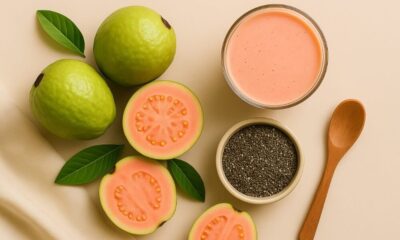

 Food & Recipes4 weeks ago
Food & Recipes4 weeks agoGuava Benefits: Why This Tropical Superfruit Deserves a Spot in Your Daily Diet
-



 Health & Wellness4 weeks ago
Health & Wellness4 weeks agoSpearmint Tea Benefits: A Natural Brew for Health
-



 Food & Recipes4 weeks ago
Food & Recipes4 weeks agoWhy Butterfly Pea Flower Tea Is the Superfood to Try in 2025: Blue Tea Benefits








